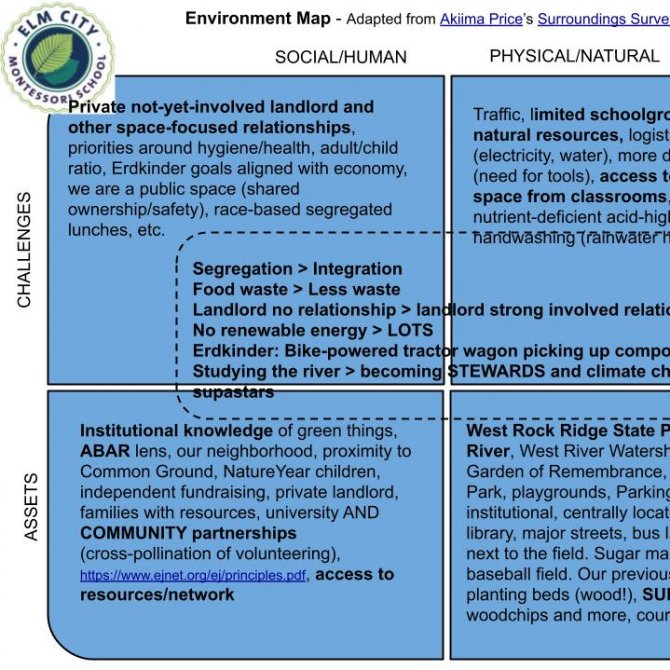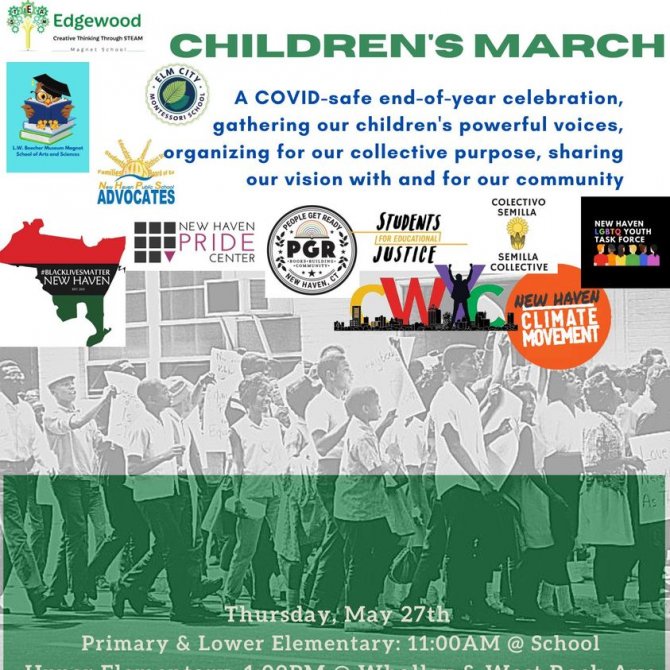_1.jpg)
School Context: Our student body (currently about 250 students) represents much of the diversity of New Haven, and the school is committed to maintaining a diverse school community. We serve PreK-7th grade students, and will grow to serve students through 8th grade. The grand majority of our students live in New Haven, we accept a small number of students via the ACES Open Choice process, who live in surrounding towns. Most of our students have been with us since Pre-K (age 3). Our school (located at 495 Blake Street, in Westville, New Haven, Connecticut) is adjacent to a treasure trove of natural resources. To learn more about our school, visit our website and follow us on social media for the latest updates (Facebook) (Instagram).
Curricular Context:
- Mixed age groupings ( PreK3 - 8th Grade (currently 7th), (ages 3-6, 6-9, 9-12)
- Uninterrupted independent periods of work
- Montessori materials
- Focus on small group and 1-1 lessons
- Children choose their own work, with guidance
- Holistic Social Emotional Learning (SEL) development
- Sensorial work, practical life, outdoor learning, cosmic education
- Rooted in our core Anti-Bias Anti-Racist (ABAR) Values
Environment

Our school is adjacent to a treasure trove of natural resources. We immediately neighbor the West River, and have easy access to the expanses of West Rock Park. However, we have focused the growth of this project and student learning on space that is even more proximate, a sunny lawn on our property that we have transformed into a garden, an effort designed by educators and led by students. There is significant interest and vision for learning within Montessori philosophy about the relationship between learning and nature, and on learning in nature. We have previously used our local natural environment for learning in a variety of ways, some of which include exploratory hikes, river water testing, and plant identification. We developed this environmental map early in our year to assess the assets and challenges of our school.
We began this year with questions: How can we create space and structure for children to plan and own a sustainable school garden? How do we build ownership and champion independence for children? How can we guide them to choose roles and responsibilities? What does it mean to be a steward of nature? How do we co-create microeconomies that interact with other local economies? How do we arrange a garden, mindful of many natural and preferential factors? How do we build consensus, how do we make decisions? How do we share the labor, or establish roles, establish routines, or support our teammates, or take on specific responsibilities? How is this space already a natural classroom? How can we further establish this space as an outdoor classroom? Who is responsible for this work when we’re not in school? How can this work be especially meaningfully/restorative during a time of socially distanced learning?
The questions that have anchored us over the past year, and continues to drive the work we’re doing is….How do we embed an anti-bias anti-racist framework within our relationships with neighborhood and nature? How do we provide our children with significant opportunities to gain and share power with their ECMS and greater community? It was our goal to help students develop connections to their local environment, to build some infrastructure in our immediate vicinity, and to connect with broader work happening in our community and city.
Additional Resources
- Original “Planning our ECMS Farm” slidedeck
- “Building an ABAR School” slidedeck
- Environment Map
Expectations
We envision the relevant content to cut across many elements of what Montessorians call “Cosmic Education” and “Practical Life,” inclusive of many NGSS and CCSS standards (see ECMS nature curriculum map and Montessori/CCSS/NGSS resources below). In addition, we have chosen to frame our year of learning via NAEYC-inspired ABAR-learning themes: (Q1) Self Love, (Q2) Seeing Difference, (Q3) Recognizing Bias, (Q4) Empowered to Act. The work outdoors provides space for learning about science and nature, about history and collective communities and civilizations, explorations of self and children’s identities, as well as a myriad of connections to bias and action. The curriculum of nature and neighborhood should connect with classroom work across our grades. We want to guide students in their explorations of themselves and the world around them, and find a sense of purpose with a variety of opportunities to engage in action.
Students will explore these core questions:
- Identity: Who am I?
- Nature and Society: How do I fit in?
- Creativity and Commerce: How do I contribute?
For each question, there are deep curricular possibilities.
Identity
- We want students to explore who they are through relationships to nature and peers through an Anti-Bias and Anti-Racist lens. We want children to explore themselves through the work they do, to try on roles and identities and to process their work.
Nature and Society
- We want students to learn the processes of planting (ex. Timing, location, (a)biotic factors), the impacts of fertilizer and the challenges of pest control, to study the life cycle of plants, how seasons work, and the interaction of plants with animals (ex. Mutualism, parasitism, etc).
- We want to engage children in analyzing the historical context, of understanding the development of early human civilization through and Anti Bias and Anti Racist lens. Students will explore the origins of agriculture, and the stories that are silenced about histories and communities of the global majority and black and brown people.
Creativity and Commerce
- We want students to build skills to express themselves in their work and in the world. How do we make collective decisions, or are there other team structures we want to try? What is my role, and/or what do I want my role to be, in this project? We want students to learn how to create and nurture a successful garden that fits within communal needs (ex. produces crops that can be sold, meets customers’ demand, connects with a market, etc).
- We want students to embark upon composting, thinking through the lens of our contributions to cyclical systems. We want students to learn about where plants ‘come from,’ the distinctions between native v. invasive species, and to connect with the natural world as a source of inspiration (ex. For artmaking, for grounding calm, for writing, etc).
Additional resources:
- ECMS Nature Curriculum Map
- AMI Montessori and the Common Core State Standards
- NAEYC: Understanding Anti-Bias Education: Bringing the Four Core Goals to Every Facet of Your Curriculum
- Article: Next Generation Science Standards and the Montessori Teacher
- Learning for Justice Social Justice Standards, CASEL SEL Framework
Exhibition

We organized a number of opportunities for students (and staff) to engage in culminating tasks, helping them find a stage and engage with a meaningful audience. We believe in the power of authentic and public audiences, and sought to elevate our students' voices well beyond the schoolyard.
In late May, staff and students organized a second annual Children’s March for the neighborhood. Some created posters, others wrote and/or delivered speeches, all marched together to stand in solidarity with each other. Our PreK-K students marched around our parking lot, 1st-3rd grade students around the neighborhood, and our 4th-6th grade students gathered the strength of several schools and partners in the neighborhood to congregate at Edgewood Park. See articles linked below for a sense of the real impact/contribution of students’ work on our local environment.
In addition, we finished the year with several other opportunities for students to exhibit their ‘power to act.’ Upper Elementary (4th-6th grade) students conclude the year with magnum opus projects, deep studies of a particular topic (many of whom chose to focus on topics of flora, fauna, New Haven, etc) (Magnum Opus instructions below). Finally, there is a 6th grade Bequeathment Ceremony, where 6th grade students share words of reflection and wisdom with their younger classmates. We want to provide our students with a variety of opportunities to see their values in action.
Additional resources:
- Arts Paper: Children’s March Taps Into Civil Rights History
- Channel 3: Annual Children’s March held in New Haven
- New Haven Independent: 1963 Children’s March Commemorated
- Magnum Opus Report about Climate Change
- Magnum Opus Report: Squirrels
Experience
To prepare for the Children’s March, our students studied the history of the Birmingham Children’s Crusade of 1963 (see collected resources below). We believe in community and youth power; 1963 was a pivotal moment in history including the 16th Street church bombing, integration and the Children's March. As a way to honor the youth leaders of this significant march, we are marching and amplifying youth voices. Our students worked to focus on projects of passion, to study themes of environmental social justice that personally resonate (ex. Environmental sustainability, LGBTQ advocacy, climate change, police brutality, affordable housing). For the march itself, our anchor community partners included the following schools and organizations:
Schools: L.W. Beecher Museum Magnet School of Arts and Sciences, Edgewood Creative Thinking Through Steam Magnet, New Haven Academy, Davis Academy For Arts And Design Innovation Magnet School
Organizations: Black Lives Matter New Haven, New Haven Pride Center, Citywide Youth Coalition, City of New Haven LGBTQ Youth Task Force, New Haven Climate Movement, People Get Ready, Semilla Collective, Students for Educational Justice, and New Haven Public School Advocates
Additional resources:
- Children’s March Study Resources
- Magnum Opus Directions
- Magnum Opus Presentation about GMO Foods
- Magnum Opus Presentation: Squirrels
- New Haven Independent: School is in Session: Outdoors
Reflections
Over the course of the year, our children did deepen their connections to their natural environment. As we developed the infrastructure of our green space (ex. Gardens, outdoor classroom, hiking program, learning outdoors/outdoor learning), students gained significantly from the opportunity to experience this new ‘area of programming.’ Concurrently, students have increasingly felt connected to issues that face our city, and the work we’ve done over time to help them answer those core questions (Identity: Who am I? Nature and Society: How do I fit in? Creativity and Commerce: How do I contribute?) was showcased in the final culminating exhibitions. Many students feel connected to nature and neighborhood, and have had opportunities to share this with others.
Areas of growth: I think there is still more work to do to more seamlessly weave NGSS standards in our programming, so ensure we are doing this work with higher order thinking skills in mind. I think that the ways in which our teams align in how outdoor learning happens is an area to strengthen, as currently teachers current levels of experience in outdoor learning and/or Anti-Bias Anti-Racist teaching meaningfully impacts student experience. Perhaps more importantly, I want us to continue thinking about audience. We organized our own march, but surely there are more opportunities to cosponsor the work of others in our neighborhood and city, and support our students in taking responsibility for leading, and not just co-facilitating with adults. We are excited for the year to come and the many opportunities this work holds for our community.
